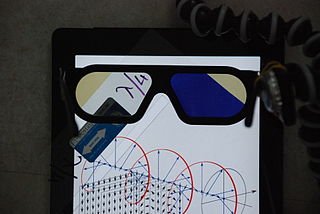
Video is an electronic medium for the recording, copying, playback, broadcasting, and display of moving visual media. Video was first developed for mechanical television systems, which were quickly replaced by cathode-ray tube (CRT) systems, which, in turn, were replaced by flat-panel displays of several types.

Media player software is a type of application software for playing multimedia computer files like audio and video files. Media players commonly display standard media control icons known from physical devices such as tape recorders and CD players, such as play, pause, fastforward (⏩️), rewind (⏪), and stop buttons. In addition, they generally have progress bars, which are sliders to locate the current position in the duration of the media file.

Stereoscopy is a technique for creating or enhancing the illusion of depth in an image by means of stereopsis for binocular vision. The word stereoscopy derives from Greek στερεός (stereos) 'firm, solid' and σκοπέω (skopeō) 'to look, to see'. Any stereoscopic image is called a stereogram. Originally, stereogram referred to a pair of stereo images which could be viewed using a stereoscope.
3D films are motion pictures made to give an illusion of three-dimensional solidity, usually with the help of special glasses worn by viewers. They have existed in some form since 1915, but had been largely relegated to a niche in the motion picture industry because of the costly hardware and processes required to produce and display a 3D film, and the lack of a standardized format for all segments of the entertainment business. Nonetheless, 3D films were prominently featured in the 1950s in American cinema, and later experienced a worldwide resurgence in the 1980s and 1990s driven by IMAX high-end theaters and Disney-themed venues. 3D films became increasingly successful throughout the 2000s, peaking with the success of 3D presentations of Avatar in December 2009, after which 3D films again decreased in popularity. Certain directors have also taken more experimental approaches to 3D filmmaking, most notably celebrated auteur Jean-Luc Godard in his film Goodbye to Language.

A 3D display is a display device capable of conveying depth to the viewer. Many 3D displays are stereoscopic displays, which produce a basic 3D effect by means of stereopsis, but can cause eye strain and visual fatigue. Newer 3D displays such as holographic and light field displays produce a more realistic 3D effect by combining stereopsis and accurate focal length for the displayed content. Newer 3D displays in this manner cause less visual fatigue than classical stereoscopic displays.

A head-mounted display (HMD) is a display device, worn on the head or as part of a helmet, that has a small display optic in front of one or each eye. HMDs have many uses including gaming, aviation, engineering, and medicine.

Rockbox is a free and open-source software replacement for the OEM firmware in various forms of digital audio players (DAPs) with an original kernel. It offers an alternative to the player's operating system, in many cases without removing the original firmware, which provides a plug-in architecture for adding various enhancements and functions. Enhancements include personal digital assistant (PDA) functions, applications, utilities, and games. Rockbox can also retrofit video playback functions on players first released in mid-2000. Rockbox includes a voice-driven user-interface suitable for operation by visually impaired users.

JRiver Media Center is a multimedia application that allows the user to play and organize various types of media on a computer running Windows, macOS, or Linux operating systems. Developed by JRiver, Inc., it is offered as shareware.

An active shutter 3D system is a technique of displaying stereoscopic 3D images. It works by only presenting the image intended for the left eye while blocking the right eye's view, then presenting the right-eye image while blocking the left eye, and repeating this so rapidly that the interruptions do not interfere with the perceived fusion of the two images into a single 3D image.

A polarized 3D system uses polarization glasses to create the illusion of three-dimensional images by restricting the light that reaches each eye.

Anaglyph 3D is the stereoscopic 3D effect achieved by means of encoding each eye's image using filters of different colors, typically red and cyan. Anaglyph 3D images contain two differently filtered colored images, one for each eye. When viewed through the "color-coded" "anaglyph glasses", each of the two images is visible to the eye it is intended for, revealing an integrated stereoscopic image. The visual cortex of the brain fuses this into the perception of a three-dimensional scene or composition.

Autostereoscopy is any method of displaying stereoscopic images without the use of special headgear, glasses, something that affects vision, or anything for eyes on the part of the viewer. Because headgear is not required, it is also called "glasses-free 3D" or "glassesless 3D".

A parallax barrier is a device placed in front of an image source, such as a liquid crystal display, to allow it to show a stereoscopic or multiscopic image without the need for the viewer to wear 3D glasses. Placed in front of the normal LCD, it consists of an opaque layer with a series of precisely spaced slits, allowing each eye to see a different set of pixels, so creating a sense of depth through parallax in an effect similar to what lenticular printing produces for printed products and lenticular lenses for other displays. A disadvantage of the method in its simplest form is that the viewer must be positioned in a well-defined spot to experience the 3D effect. However, recent versions of this technology have addressed this issue by using face-tracking to adjust the relative positions of the pixels and barrier slits according to the location of the user's eyes, allowing the user to experience the 3D from a wide range of positions. Another disadvantage is that the horizontal pixel count viewable by each eye is halved, reducing the overall horizontal resolution of the image.
Phantograms, also known as Phantaglyphs, Op-Ups, free-standing anaglyphs, levitated images, and book anaglyphs, are a form of optical illusion. Phantograms use perspectival anamorphosis to produce a 2D image that is distorted in a particular way so as to appear, to a viewer at a particular vantage point, three-dimensional, standing above or recessed into a flat surface. The illusion of depth and perspective is heightened by stereoscopy techniques; a combination of two images, most typically but not necessarily an anaglyph. With common (red–cyan) 3D glasses, the viewer's vision is segregated so that each eye sees a different image.
TDVision Systems, Inc., was a company that designed products and system architectures for stereoscopic video coding, stereoscopic video games, and head mounted displays. The company was founded by Manuel Gutierrez Novelo and Isidoro Pessah in Mexico in 2001 and moved to the United States in 2004.
Digital 3D is a non-specific 3D standard in which films, television shows, and video games are presented and shot in digital 3D technology or later processed in digital post-production to add a 3D effect.

3D television (3DTV) is television that conveys depth perception to the viewer by employing techniques such as stereoscopic display, multi-view display, 2D-plus-depth, or any other form of 3D display. Most modern 3D television sets use an active shutter 3D system or a polarized 3D system, and some are autostereoscopic without the need of glasses. As of 2017, most 3D TV sets and services are no longer available from manufacturers.
Multi View Video Coding is a stereoscopic video coding standard for video compression that allows for encoding video sequences captured simultaneously from multiple camera angles in a single video stream. It uses the 2D plus Delta method and it is an amendment to the H.264 video compression standard, developed jointly by MPEG and VCEG, with the contributions from a number of companies, such as Panasonic and LG Electronics.

The Fujifilm FinePix Real 3D W series is a line of consumer-grade digital cameras designed to capture stereoscopic images that recreate the perception of 3D depth, having both still and video formats while retaining standard 2D still image and video modes. The cameras feature a pair of lenses, and an autostereoscopic display which directs pixels of the two offset images to the user's left and right eyes simultaneously. Methods are included for extending or contracting the stereoscopic baseline, albeit with an asynchronous timer or manually depressing the shutter twice. The dual-lens architecture also enables novel modes such as simultaneous near and far zoom capture of a 2D image. The remainder of the camera is similar to other compact digital cameras.

A stereoscopic video game is a video game which uses stereoscopic technologies to create depth perception for the player by any form of stereo display. Such games should not be confused with video games that use 3D game graphics on a mono screen, which give the illusion of depth only by monocular cues but lack binocular depth information.













